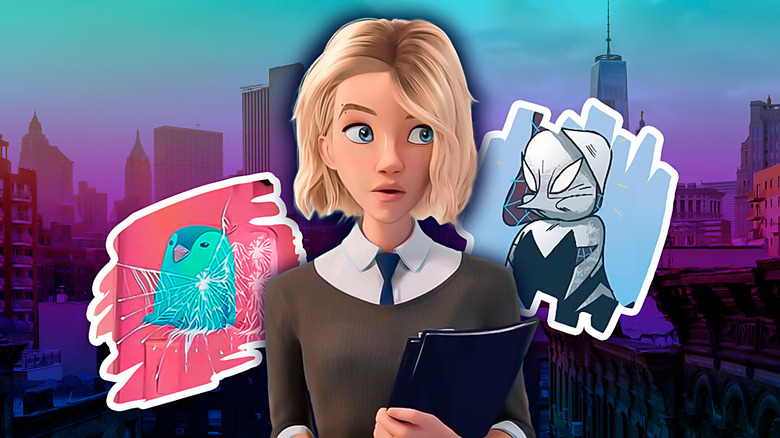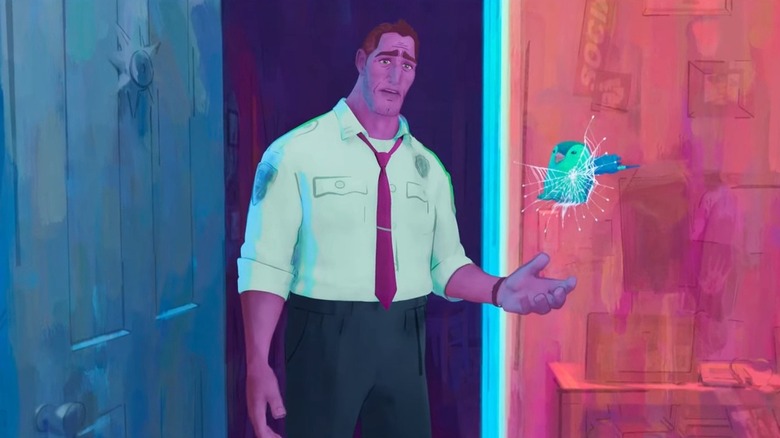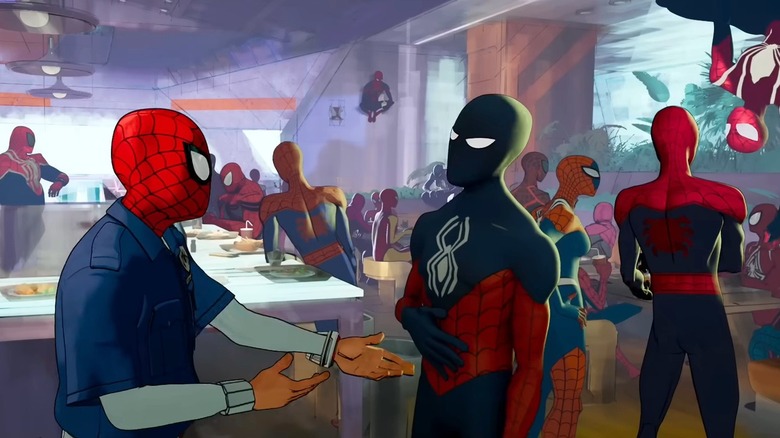Across The Spider-Verse's Penguin Has Spider-Gwen Fans Looking Twice
There are more Easter eggs in "Spider-Man: Across the Spider-Verse" than there are in most comic book movies. Coming five years after "Spider-Man: Into the Spider-Verse," the critically acclaimed sequel managed to not only bring viewers into even more unique, gorgeously animated worlds than its predecessor, but it did so while also packing in more comic book and superhero movie references than even the most die-hard fans could have ever expected. Indeed, months after it hit theaters this past summer, viewers are still finding new details to pick apart and obsess over in the film.
On TikTok, one user reposted the third-act reunion between Gwen Stacy (Hailee Steinfeld) and her father, George (Shea Whigham), that helps wrap up the latter's personal journey in "Spider-Man: Across the Spider-Verse." In the post's comments, however, viewers didn't latch onto the intense emotions present during Gwen's conversation with her father, but the scene's inclusion of a stuffed penguin that appears very early on in it. Fans specifically noted that the penguin appears for the first time in Gwen's bedroom window reflection and speculated that it's initially made to look like a gun in her father's hand.
That theory explains why Gwen instinctively shoots a web at the stuffed penguin — prompting her father to tell her to go easy on it. Some comic book fans, meanwhile, have suggested that the penguin's very presence in "Spider-Man: Across the Spider-Verse" may be a reference to an absurd comic book variant of Spider-Gwen: Penguin Stacy, a.k.a. Spider-Guin.
Gwen Stacy's stuffed penguin may be a sneaky comic book reference
There are hundreds of versions of Spider-Man featured in "Spider-Man: Across the Spider-Verse." However, one web-slinging variant that isn't actually included in the film is Spider-Guin. The obscure comic book character is a resident of Earth-8311, the same world as Spider-Ham, who is voiced by John Mulaney in "Spider-Man: Into the Spider-Verse." An anthropomorphic animal variant of Gwen Stacy, Spider-Guin is a penguin imbued with spider-like abilities.
Penguin Stacy's existence adds some unexpected layers to Gwen's emotional reconciliation with her father in "Spider-Man: Across the Spider-Verse." Referencing George Stacy's comment about his daughter shooting a web at her stuffed penguin, one TikTok commenter even observed, "'You wanna go easy on the penguin?' has layers [because] Gwen is a penguin in [Spider-Ham's] universe. He's asking her to go easy on herself."
As dark as it is that Gwen initially thinks her father is holding a gun at her at the start of the scene in question, the detail itself represents a small, full-circle moment. After all, the prologue of "Spider-Man: Across the Spider-Verse" ends with George holding Spider-Gwen up at gunpoint and trying to arrest her. Additionally, while it's still unclear whether or not viewers will ever get to see Penguin Stacy brought to life onscreen, it's worth noting that "Across the Spider-Verse" does end with Gwen recruiting some of her multiversal friends to help her save Miles, including Spider-Man Noir (Nicolas Cage) and, yes, Spider-Ham.
The reintroduction of the latter character could present the door for either a Spider-Guin appearance in "Spider-Man: Beyond the Spider-Verse" or a trip to the character's universe.
Across the Spider-Verse's countless variants serve an important purpose
Regardless of whether or not Spider-Guin actually appears in its sequel, it's worth noting that there's a legitimate reason why so many web-slinging variants appear in "Spider-Man: Across the Spider-Verse." They aren't just there to pay homage to the film's comic book source material or make fans happy. On the contrary, the film's countless wall-crawlers help it emphasize the weight of Miles Morales' decision to blaze his own trail.
As one of the movie's producers and co-writers, Phil Lord, explained in an interview with The Wall Street Journal, "He's basically trying to assert his uniqueness amongst throngs, so there had to be a lot of them." In the film's second half, Miles decides to defy Miguel O'Hara (Oscar Isaac) by trying to save his father from dying at the hands of The Spot (Jason Schwartzman). In doing so, Miles puts himself in direct opposition to Miguel and risks tearing apart the entire fabric of the multiverse.
Viewers understand the importance of Miles' decision because they're shown just how many of his fellow web-slingers have chosen a different path than him. The film, to its credit, doesn't just render all of its various Spider-Men as faceless nobodies, either. Instead, it manages to make each of them feel singular and distinct. According to Lord, that was always the intention of the movie's creative team.
"The point of replicating these characters is not that they're the same but that they're all unique," he noted. "They all have internal lives that, if you put a lens on them, become visible." With that in mind, fans will likely just have to wait to see whether the film's sequel adds Penguin Stacy to its franchise's already impressive roster of friendly neighborhood variants.


